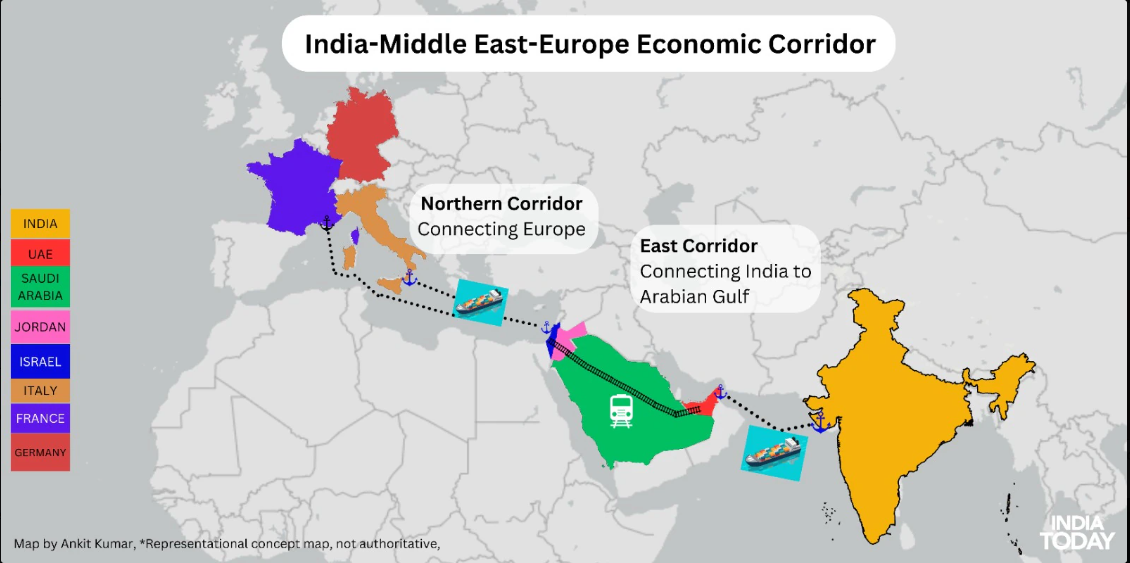ForumIAS announcing GS Foundation Program for UPSC CSE 2025-26 from 19 April. Click Here for more information.
Contents
| For 7PM Editorial Archives click HERE → |
India Middle East Europe Corridor was launched at the recently concluded G20 summit 2023 in India. A Memorandum of Understanding (MoU) was signed between the Governments of India, the US, Saudi Arabia, the European Union (EU), the UAE, France, Germany and Italy to establish this economic Corridor.
What is India Middle East Europe Corridor (IMEC)?
India Middle East Europe Corridor is a network of transport corridors comprising railway lines and sea lanes to promote economic integration between Asia, the Arabian Gulf, and Europe.
Project Details- The proposed corridor will comprise of two separate corridors- the Eastern corridor and the Northern corridor. The Eastern Corridor will connect India to the Arabian Gulf and the Northern Corridor will connect the Arabian Gulf to Europe.
It will involve transit by ship between India and Saudi Arabia, followed by a rail link to the UAE and likely to Jordan from where the shipment will move by sea to Turkey and further by rail.
Along with the railway track, cables for energy and digital connectivity as well as a pipeline for clean hydrogen export will be laid.
Member Countries – India, US, UAE, Saudi Arabia, European Union (EU), Italy, France and Germany.
Part of – It is part of the Partnership for Global Infrastructure Investment (PGII) which is a collaborative effort by G7 nations to fund infrastructure projects in developing nations. PGII is the G7 bloc’s counter to China’s Belt and Road Initiative. PGII is part of G7’s vision of Build-Back-Better framework.
Graphical Representation of the project-

What is the Significance of India Middle East Europe Corridor?
Geo-Political Significance
Counter to Chinese Belt and Road Initiative (BRI) – India Middle East Europe Corridor (IMEC) is an ambitious counter to China’s BRI project. BRI has created a ‘debt trap’ and has diminished the sovereignty of member countries. It will be a counter to the expansionist policies of China.
Counter to China’s growing geopolitical Influence in Middle East- China’s geopolitical influence has been growing in the Middle East region. China has helped to broker a deal between Saudi Arabia and Iran. Saudi Arabia and the UAE-both old allies of US-have been strengthening their ties with China. It also provides an opportunity to counter the growing Chinese geopolitical influence.
Geopolitical Stability in Middle East – This Corridor will help to bring countries in the Middle East together and establish that region as a hub for economic activity instead of as a “source of challenge, conflict or crisis” as it has been in recent history.
Normalisation of Diplomatic Relations- It would help normalise diplomatic relations in the Middle east with possibility of establishment of diplomatic relations between Israel and Saudi Arabia both of which are part of the project.
Reduced geopolitical dependence on Suez Canal and red sea – Suez Canal has been witnessing congestions in the recent times. Further the Red Sea with straits of Bab-al-Mandeb and Gulf of Aden is being militarised by China through its militarised naval bases like the Port of Doraleh. It will open an alternate route for transportation.
Expansion of G20 role from purely economic grouping to geo-political grouping- This project is also an attempt to further strengthen the G20 group by expanding the role of G-20 to geo-political domain to counter the dominance of China’s Xi Jinping and Russia’s Vladimir Putin.
Geo-Economic Significance
Increase in Trade and employment opportunities- This proposed corridor project would increase the trade of manufactured goods and facilitate the development of clean energy. It would increase efficiencies, save costs, promote economic cohesion, create jobs, leading to a radical integration of Asia, Europe, and the Middle East.
Development of Infrastructure- This proposed economic corridor project would help deal with the lack of infrastructure needed for growth in lower and middle-income nations. IMEC will be a green and digital bridge across continents and civilizations as the corridor will include a rail link as well as an electricity cable, a hydrogen pipeline and a high-speed data cable.
Promotion of Intra-regional Connectivity- It will promote Intra-regional connectivity and enhance trade, prosperity and connectivity.
What is the Significance of IMEC for India?
Launch of this connectivity corridor project is of immense significance to India.
Indo-US convergence in Middle East- India and US have converged their interests in Middle East after Indo Pacific. This economic and connectivity project is the second mega convergence between India and the United States in Middle East after the I2U2 forum. It can turn out to be far more significant for Indo-US relationship.
Read More-I2U2
Strategic engagement with the Arabian Peninsula- Through this connectivity project the Indian govt now has an opportunity to build enduring connectivity between India and Arabia. The current project will strengthen India’s role as a driver in shaping regional connectivity.
Breaking Pakistan’s dominance- It breaks Pakistan’s monopoly over India’s overland connectivity to the West. Since the 1990s Delhi has sought various trans-regional connectivity projects with Pakistan. But Islamabad was adamant in its refusal to let India gain access to land-locked Afghanistan and Central Asia.
Reduced dependence on Iran- It also provides India an alternate transport corridor route for Europe by reducing over dependence on Chabahar Port and INSTC.
Opportunity to join Trans-African Corridor- Trans-African corridor is an envisaged US and the EU plan to build a corridor connecting Angola, the Democratic Republic of Congo, and Zambia. Effective implementation of Indian Middle East Europe Corridor project would increase India’s chances of getting an opportunity to join Trans-African corridor.
Increase in Trade Competitiveness-According to US report this economic corridor will make trade between India and Europe 40% faster. This will increase the trade competitiveness of Indian exports.
What are the possible challenges for India Middle East Europe Economic Corridor?
Non-binding MoU- MoU of IMEC does not create any rights or obligations under international law. The memorandum only sets forth political commitments of its participants which are non-binding.
Implementation on Ground- Early implementation and construction of this corridor is a challenge that member countries face. As per the MoU, the members intend to meet within the next sixty days to develop and commit to an action plan with relevant timetables. Early groundbreaking of the project is a major challenge the corridor faces.
Finance-The Corridor would require massive finance for its construction. Arrangement of such funds is a challenge considering the recession that has been creeping in US and other advanced economies. Scale of investments that can be raised by China is higher than that of the G7. Mobilisation of Private-sector finance also remains a major challenge.
Chinese Resistance-This economic corridor also faces the challenge of Chinese pushback as China as already invested heavily in BRI project. It has been making considerable investments in the middle eastern economies like Iran, Saudi Arabia and UAE.
Conclusion
Success of Indian Middle East Europe Corridor could help diversify the options available to the countries who have infrastructure requirements. The speed of implementation of the corridor and its ability to avoid the problem of financial and ecological sustainability
faced by BRI will determine the success of IMEC.
Further Reading-IMEC Indian Express




